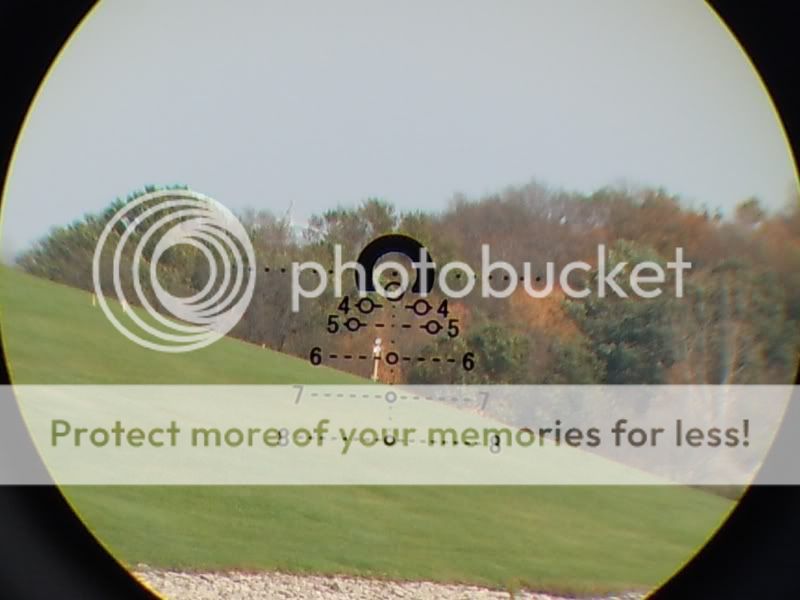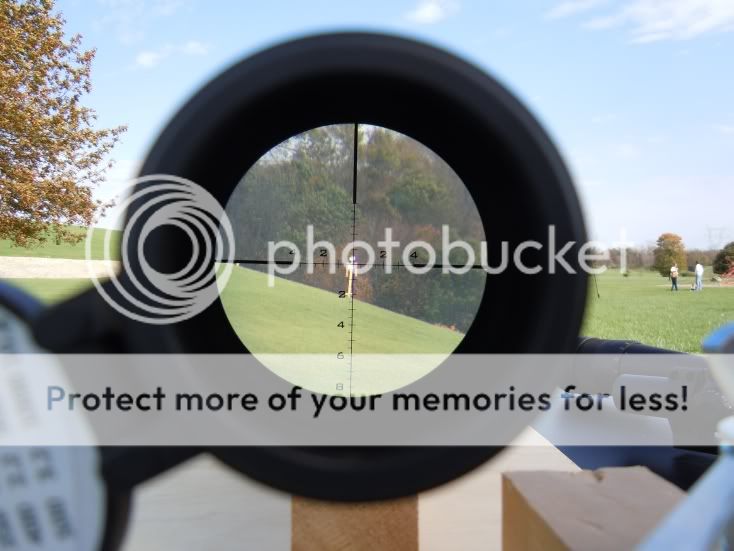MOA and mil vs. stadiametric ranging in variable low power scopes
The following is a partially completed article on ranging. In order to complete it, I need the help of many fellow forum members. Much of this article consists of a series of ranging practice photos through different scopes. In order to complete the article, I need a few folks to look at those photos and calculate the range of the stickman in them. A table of values I need for you to calculate is posted before the photos and the directions for ranging using the different scopes is provided in the text. Please do not look ahead after the photos for the answers and cheat. Your data will not be useful if you do. Please simply post your answers in this thread and as soon as I get enough of them, I will draw some conclusions and finish writing the article.
Thanks,
BigJimFish
The purpose of this article is to discuss with some substance different range finding reticles for the 1- power scope. As I have become more involved in writing reviews for this class of optics (see my variable, low power multipurpose scope review thread at:
power scope. As I have become more involved in writing reviews for this class of optics (see my variable, low power multipurpose scope review thread at:
The variable low power multipurpose scope review thread , I have become more dedicated to finding quality (by which I mean quantitative and experimentally-based) answers as to the limitations and strengths of different reticles and scopes. Quality answers are hard to come by. Questions such as, which reticles and scopes are faster in CQB and which reticles and scopes are better for long range shots, beg answers. Over the course of the next year or so I will be attempting to put together some relevant experiments and analysis to answer these questions.
This particular article will be dealing specifically with the range finding capabilities and limitations of different reticles. Range finding reticles for the 1- power class roughly divide into two camps. In the first camp you will find mil and MOA ladder or dot type reticles. Range finding with reticles of this type involves viewing an object of known actual size through the scope and using the reticle to determine how many mils or MOA it subtends. A calculation is then performed, yielding the distance. Formulas exist for different input and output values. A good resource for all of these equations is Robert J. Simeone's fact sheet which can be found at: MOA and mil ranging equations . If you desire to dig deeper for the proofs of these equations, he provides them here: Understanding mil and MOA equations. For our purposes, we will be using the equation Actual height of the target (inches)/mils on reticle * 27.78 = distance to target (yards.) This is not at all the most elegant of the equations since it combines both Metric and English elements, but it will have to do since of the four scopes I used in these tests, half were Metric and half were English. I had to choose one of the two systems for the values posted in this article and I went with English because I use it more often.
power class roughly divide into two camps. In the first camp you will find mil and MOA ladder or dot type reticles. Range finding with reticles of this type involves viewing an object of known actual size through the scope and using the reticle to determine how many mils or MOA it subtends. A calculation is then performed, yielding the distance. Formulas exist for different input and output values. A good resource for all of these equations is Robert J. Simeone's fact sheet which can be found at: MOA and mil ranging equations . If you desire to dig deeper for the proofs of these equations, he provides them here: Understanding mil and MOA equations. For our purposes, we will be using the equation Actual height of the target (inches)/mils on reticle * 27.78 = distance to target (yards.) This is not at all the most elegant of the equations since it combines both Metric and English elements, but it will have to do since of the four scopes I used in these tests, half were Metric and half were English. I had to choose one of the two systems for the values posted in this article and I went with English because I use it more often.
After finding the target range using a mil or MOA reticle scope, bullet drop may be compensated for in two principle ways. The elevation adjustment may be used to compensate using drop values from a table or, alternately, you may dial the drop using a custom elevation knob that is calibrated to your rife and load. The other method to compensate for bullet drop is to utilize the ladder or dots themselves and hold the correct distance over the target as indicated by said table. Typically, the MOA or mil reticle does not include any bullet drop compensating elements etched in the reticle since the range must be calculated and this is time consuming. It is assumed that if you have the time for a range calculation, you will also have time to compensate for the drop using a more precise method. It can therefore be seen that in regards to both ranging and drop compensation, a mil or MOA type reticle uses the more accurate, but also more time consuming method.
The second main type of range finding reticle is what I will refer to as the stadiametric type. Though technically mil and MOA ladder and dot reticles also utilize the mathematical principle that in similar triangles, homologous sides are proportional; these reticles are not commonly referred to as stadiametric. Instead, stadiametric reticles are generally those that range by representing a single object (the stadia) at different distances on the reticle. Some examples of this are the Trijicon TA31 series of scopes which use the chest width of a man as their stadia, the GRSC which uses 10" circles and lines as its stadia, and the Russian PSO-1 scope that uses the height of a standing man as its stadia. Stadiametric reticles do not require the user to do any calculations. Instead, the object being ranged is simply lined up with the correct size element on the reticle and the range is read. In keeping with the quick and dirty focus of this type of range finding, most, though not all, stadiametric reticles incorporate the bullet drop compensation directly into the reticle, allowing for extremely quick range finding and drop compensation. This compensation is, of course, limited to the round and platform it was calibrated for and becomes less accurate the more the round and platform differs from what it was designed for. It is notable though, that on many scopes, nothing prevents the user of a stadiametric reticle from dialing the precise drop using a table or custom BDC knob in the same manner as mil dot user. I have tested several scopes, most notably the GRSC 1-6x and the Vortex Razor HD with EBR-556 reticle, that were equipped with excellent and accurate tool-less elevation knobs.
This brings us to the crux of our dilemma. Given the choice of quick range finding that requires no math and sacrifices no accuracy, we would be insane to choose the lengthy approach. This is not the case though. Accuracy is sacrificed as well as, in many cases, versatility. Most stadiametric reticles use dimensions of the human body and I for one have never shot at a human body. Though the GRSC reticle mitigates this somewhat by including 10" hash marks and 10" gaps that can be easily used to range anything; other reticles, such as the Trijicon, are less versatile.
What we are concerned about is how much accuracy are we giving up going with the quick stadiametric route. Since the accuracy of the reticle decreases with distance while the accuracy required for a hit increases it is not hard to see that at some distance our ranging will not be accurate enough to reliably hit the target. It is important to have some idea of what this distance is and how much shooting could we really expect to do beyond that range.
I would love to say that the following experiment and data will answer all of these questions definitively, but that is far from the case. What I present here is a very limited set of data (3 scopes at 4 distances each) that may or may not be a close enough approximation of real usage (photographs through scopes of a stick man instead of looking through scopes live at a variety of targets) to have any relevance whatsoever. I'm going to make the argument that some data regarding these questions is better than none, but feel free to make the argument that a little knowledge is more dangerous than none at all since it inspires false confidence.
What I present below is a set of photographs of a wooden man who has a head of 9.5" diameter, shoulders of 19" breadth, and a height of 69." His height is measured from the bottom of the foot crossbeam to the top of his plate head. His breadth is measured from the outside of each arm at the shoulder. I have photographed him at 4 distances through three scopes. Each photo has been scaled to appear to you as if you are viewing the target through the scope at 6x, provided you are sitting the correct distance from the monitor (three feet). This was done to remove the advantage that higher magnification optics enjoy. Pixel size on different folks' monitors will vary and if you want to test how different yours is from mine, measure the height of the stick man in the 1st position (any scope will do) he should be 16mm tall on your monitor. Note that since each photo has been scaled and altered for ranging purposes, they are really not suitable for judging these scopes clarity by. Your job is to estimate each of the distances through each scope. You may do the GRSC or Trijicon first, but be sure to do the mil scope last as it is very accurate and will bias you.
The GRSC scope I used for the reticle is the very nice 1-6x Japanese version I reviewed here: GRSC scope review . It, as well as the GRSC 1-4x, uses a reticle I refer to as the "Base 10" reticle because most elements represent 10" at the distance labeled. For example look at the line labeled "6". This is the 600 yard line. The inside of the circle represents 10" at 600 yards. Also, each dash is 10" as well as each gap between dashes. Therefore the circle can be used to range the head, whereas the gaps and dashes will range the shoulder breadth nicely. I suggest you utilize both when calculating range.
The Trijicon used is a TA31A 4x scope. It ranges using chest width stadia lines. Take a look at the line labeled "6". This line corresponds to 18" at 600 meters. These lines are therefore very useful for calculating range based on chest width. Take note that the Trijicon ranges in meters so multiply your range in meters by 1.09361 to get the range in yards for your table.
The mil scope used is a US Optics 5-25x sniper scope with the GAP reticle. Its graduations are marked in mils. They are only labeled every 2 mils, but it has hash marks every .5 mils. For the mil scope, use the following formula to find the distance in yards: Actual height of the target (69 inches)/mils subtended on reticle * 27.78 = distance to target (yards.)
Below is the table that you will be filling in with your data. You will find the actual distances at the end of this post following the pics - don't cheat and look ahead. Distances are accurate to within 1.5%:
Table for organizing your ranges:

Distance 1 through GRSC:

Distance 2 through GRSC:

Distance 3 through GRSC:

Distance 4 through GRSC:

Distance 1 through Trijicon:

Distance 2 through Trijicon:

Distance 3 through Trijicon:

Distance 4 through Trijicon:

The following is a partially completed article on ranging. In order to complete it, I need the help of many fellow forum members. Much of this article consists of a series of ranging practice photos through different scopes. In order to complete the article, I need a few folks to look at those photos and calculate the range of the stickman in them. A table of values I need for you to calculate is posted before the photos and the directions for ranging using the different scopes is provided in the text. Please do not look ahead after the photos for the answers and cheat. Your data will not be useful if you do. Please simply post your answers in this thread and as soon as I get enough of them, I will draw some conclusions and finish writing the article.
Thanks,
BigJimFish
The purpose of this article is to discuss with some substance different range finding reticles for the 1-
The variable low power multipurpose scope review thread , I have become more dedicated to finding quality (by which I mean quantitative and experimentally-based) answers as to the limitations and strengths of different reticles and scopes. Quality answers are hard to come by. Questions such as, which reticles and scopes are faster in CQB and which reticles and scopes are better for long range shots, beg answers. Over the course of the next year or so I will be attempting to put together some relevant experiments and analysis to answer these questions.
This particular article will be dealing specifically with the range finding capabilities and limitations of different reticles. Range finding reticles for the 1-
After finding the target range using a mil or MOA reticle scope, bullet drop may be compensated for in two principle ways. The elevation adjustment may be used to compensate using drop values from a table or, alternately, you may dial the drop using a custom elevation knob that is calibrated to your rife and load. The other method to compensate for bullet drop is to utilize the ladder or dots themselves and hold the correct distance over the target as indicated by said table. Typically, the MOA or mil reticle does not include any bullet drop compensating elements etched in the reticle since the range must be calculated and this is time consuming. It is assumed that if you have the time for a range calculation, you will also have time to compensate for the drop using a more precise method. It can therefore be seen that in regards to both ranging and drop compensation, a mil or MOA type reticle uses the more accurate, but also more time consuming method.
The second main type of range finding reticle is what I will refer to as the stadiametric type. Though technically mil and MOA ladder and dot reticles also utilize the mathematical principle that in similar triangles, homologous sides are proportional; these reticles are not commonly referred to as stadiametric. Instead, stadiametric reticles are generally those that range by representing a single object (the stadia) at different distances on the reticle. Some examples of this are the Trijicon TA31 series of scopes which use the chest width of a man as their stadia, the GRSC which uses 10" circles and lines as its stadia, and the Russian PSO-1 scope that uses the height of a standing man as its stadia. Stadiametric reticles do not require the user to do any calculations. Instead, the object being ranged is simply lined up with the correct size element on the reticle and the range is read. In keeping with the quick and dirty focus of this type of range finding, most, though not all, stadiametric reticles incorporate the bullet drop compensation directly into the reticle, allowing for extremely quick range finding and drop compensation. This compensation is, of course, limited to the round and platform it was calibrated for and becomes less accurate the more the round and platform differs from what it was designed for. It is notable though, that on many scopes, nothing prevents the user of a stadiametric reticle from dialing the precise drop using a table or custom BDC knob in the same manner as mil dot user. I have tested several scopes, most notably the GRSC 1-6x and the Vortex Razor HD with EBR-556 reticle, that were equipped with excellent and accurate tool-less elevation knobs.
This brings us to the crux of our dilemma. Given the choice of quick range finding that requires no math and sacrifices no accuracy, we would be insane to choose the lengthy approach. This is not the case though. Accuracy is sacrificed as well as, in many cases, versatility. Most stadiametric reticles use dimensions of the human body and I for one have never shot at a human body. Though the GRSC reticle mitigates this somewhat by including 10" hash marks and 10" gaps that can be easily used to range anything; other reticles, such as the Trijicon, are less versatile.
What we are concerned about is how much accuracy are we giving up going with the quick stadiametric route. Since the accuracy of the reticle decreases with distance while the accuracy required for a hit increases it is not hard to see that at some distance our ranging will not be accurate enough to reliably hit the target. It is important to have some idea of what this distance is and how much shooting could we really expect to do beyond that range.
I would love to say that the following experiment and data will answer all of these questions definitively, but that is far from the case. What I present here is a very limited set of data (3 scopes at 4 distances each) that may or may not be a close enough approximation of real usage (photographs through scopes of a stick man instead of looking through scopes live at a variety of targets) to have any relevance whatsoever. I'm going to make the argument that some data regarding these questions is better than none, but feel free to make the argument that a little knowledge is more dangerous than none at all since it inspires false confidence.
What I present below is a set of photographs of a wooden man who has a head of 9.5" diameter, shoulders of 19" breadth, and a height of 69." His height is measured from the bottom of the foot crossbeam to the top of his plate head. His breadth is measured from the outside of each arm at the shoulder. I have photographed him at 4 distances through three scopes. Each photo has been scaled to appear to you as if you are viewing the target through the scope at 6x, provided you are sitting the correct distance from the monitor (three feet). This was done to remove the advantage that higher magnification optics enjoy. Pixel size on different folks' monitors will vary and if you want to test how different yours is from mine, measure the height of the stick man in the 1st position (any scope will do) he should be 16mm tall on your monitor. Note that since each photo has been scaled and altered for ranging purposes, they are really not suitable for judging these scopes clarity by. Your job is to estimate each of the distances through each scope. You may do the GRSC or Trijicon first, but be sure to do the mil scope last as it is very accurate and will bias you.
The GRSC scope I used for the reticle is the very nice 1-6x Japanese version I reviewed here: GRSC scope review . It, as well as the GRSC 1-4x, uses a reticle I refer to as the "Base 10" reticle because most elements represent 10" at the distance labeled. For example look at the line labeled "6". This is the 600 yard line. The inside of the circle represents 10" at 600 yards. Also, each dash is 10" as well as each gap between dashes. Therefore the circle can be used to range the head, whereas the gaps and dashes will range the shoulder breadth nicely. I suggest you utilize both when calculating range.
The Trijicon used is a TA31A 4x scope. It ranges using chest width stadia lines. Take a look at the line labeled "6". This line corresponds to 18" at 600 meters. These lines are therefore very useful for calculating range based on chest width. Take note that the Trijicon ranges in meters so multiply your range in meters by 1.09361 to get the range in yards for your table.
The mil scope used is a US Optics 5-25x sniper scope with the GAP reticle. Its graduations are marked in mils. They are only labeled every 2 mils, but it has hash marks every .5 mils. For the mil scope, use the following formula to find the distance in yards: Actual height of the target (69 inches)/mils subtended on reticle * 27.78 = distance to target (yards.)
Below is the table that you will be filling in with your data. You will find the actual distances at the end of this post following the pics - don't cheat and look ahead. Distances are accurate to within 1.5%:
Table for organizing your ranges:

Distance 1 through GRSC:

Distance 2 through GRSC:

Distance 3 through GRSC:

Distance 4 through GRSC:

Distance 1 through Trijicon:
Distance 2 through Trijicon:
Distance 3 through Trijicon:
Distance 4 through Trijicon:





